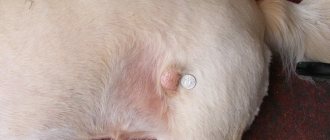Every third four-legged friend has been lost at least once. Unfortunately, 90% of the total number of lost animals are not returned to their owners. Despite the use of collars with phone numbers and branding, many pets disappear without a trace. The microchipping method, recently created for identification purposes, can be used to help find pets. How to find a dog by chip, what are the features of this procedure, read on.
How to find a dog by chip
Why do you need microchipping?
Chipping is a method of electronic recognition of animals. It is based on the technology of implanting a microchip into the subcutaneous layer.
The chip is a microscopic circuit in a capsule made of harmless glass, compatible with the tissues of a living organism. It is slightly larger in size than a grain of rice - 2x12 mm or 1.4x8.5 mm.
Microchipping is a modern alternative to painful animal branding
The introduction of a chip is a simple surgical procedure. In terms of pain level, it resembles vaccination. The procedure is safe for the animal and takes only a few minutes. It does not require the use of anesthetics. Within 7 days after administration, the biocapsule grows into the surrounding tissue and is not felt by the pet.
Upon completion of microchipping, the animal owner is given an identification card - a kind of electronic passport. It is a legal document confirming ownership of the dog. The chip contains a 15-digit code, which, when read by a clinic representative’s scanner, provides the following information:
- country and region of residence;
- name of the breed and nickname of the pet;
- health status;
- vaccination history;
- contact information and coordinates of the owner;
- the name of the clinic where the procedure was performed.
Microchip code structure
A sticker with a barcode is placed in the pedigree and veterinary passport of the animal.
Microchipping is allowed from the age of 5 weeks.
On the 35th day of birth, the puppy can have a chip implanted.
Advantages and disadvantages of chipping
Since this technology appeared on the territory of the Russian Federation recently, it is shrouded in a lot of speculation. First of all, this concerns its purpose.
Microchipping was not designed to track your pet. The main purpose of this method is to identify the animal, which is especially important for representatives of elite breeds.
To understand the feasibility of a procedure, you need a clear understanding of its strengths and weaknesses.
Table 1. Advantages and disadvantages of chipping
| Advantages | Omissions |
| Safety. The service life of a capsule made of solid bioglass is designed for at least 100 years. This time period significantly exceeds the life span of the animal. | Some dogs have an individual intolerance to the components contained in the capsule shell. |
| Possibility to freely cross the border | In rare cases, migration of the implanted chip has been observed. The range of deviation of the chip from the insertion site is from 1 to 2 cm. Such migration does not have a negative effect on the body |
| Finding comprehensive information about the animal and its owner in one place and making it easy to read | There are cases when, after several years, the scanner did not read the information located in the microcircuit. Most often, this problem is associated with its demagnetization as a result of electromagnetic influence. |
| Painlessness and ease of manipulation | The absence of a painful reaction to the procedure is possible if it is performed correctly. If the injection is given by an inexperienced veterinarian, there is a high probability of suppuration at the injection site and the formation of inflammatory processes. |
| Possibility to confirm ownership of a pet. When purchasing representatives of elite varieties, the information contained in the microchip makes it possible to correctly identify | When purchasing a mature microchipped pet, you must enter information about its new owner. It may take a long time for information to be updated |
| Impossibility of replacing an animal when participating in competitions | In long-haired pets, there is a risk of incorrect implantation, in which the chip becomes entangled in the fur without reaching the epidermis |
The listed shortcomings are episodic in nature. The advantages inherent in this procedure are much greater.
In some countries, vaccines given to your pet before the chip is implanted are considered invalid.
To participate in exhibitions, the presence of a chip is a prerequisite
Is microchipping required to travel abroad?
Yes, definitely!
At the veterinary control at the airport, they will definitely check whether your pet has a microchip. When planning your trip, carefully study the rules for importing animals into the country. In some countries, for example in the European Union, microchipping is required before or on the day of rabies vaccination. The cost of microchipping a dog in our clinic is 1200 rubles. The price includes consumables and the work of a veterinarian. For this money you will protect your four-legged friend for life.
Back
Databases of microchipped animals
There is no single, comprehensive database of microchipped pets. Several large international ones have been registered, such as PetMaxx or Europetnet, but a general animal search network has not been developed.
There are 4 large information portals in Russia: Russsiapet, AnimalFace, Moi-zver and Animal-ID. Each of them is part of either Europetnet or PetMaxx.
Due to the fact that some information platforms are connected to international platforms, they have the ability to search for information about a pet all over the world. For example, such a giant as PetMaxx has combined more than 30 databases.
Many Russian databases are combined with international ones
An alternative to large resources are information portals created by veterinary clinics. Like FreeChip, which is an official member of Europetnet. This service is considered a convenient tool for the work of specialists in veterinary clinics.
Among the advantages of such Internet platforms are the following:
- free use and adding information about the animal;
- user-friendly interface;
- ease of navigation;
- reliability of data storage;
- the ability for the owner to independently make changes to the card;
- no need to install additional programs.
Upon request, the information portal provides the following information about the pet: name of the clinic where the chip was implanted, breed and nickname
How to properly chip a dog
The microchip implantation procedure is carried out in all major veterinary institutions and canine centers. You should not trust unqualified specialists. There are known cases of installing “gray” chips, which are useless due to the lack of information about them in the databases.
Chip implantation takes only a few minutes
Basic rules of execution:
- The chip is not administered to pets under 1 month of age.
- Before starting the manipulation, the functionality of the microchip is tested by reading it with a scanner.
- The animal is also scanned for the presence of the capsule, since re-chipping is prohibited.
- The injection area is treated with a disinfectant solution.
- For representatives of long-haired breeds, the chip is implanted in the area of the withers or left shoulder blade.
- For short-haired pets, the transponder is inserted into the inner thigh.
- At the end of the procedure, the operation of the chip is checked.
- After a visit to the clinic, the animal should not be bathed or combed for several days.
- For hyperactive pets, it is advisable to purchase a plastic collar that will protect the injection site from tearing.
The manipulation is painless and does not require anesthesia.
Chipping is classified as a simple procedure.
Read more about chipping in a special article.
How to find a lost dog using a chip
After implanting the microchip, the doctor who performed this manipulation must enter information about the pet into the clinic’s local database. Then the system administrator exports the received information to one of the large Russian unified databases. Upon completion of account registration, all users will have access to information about the organization that entered this data, which in turn has contact information about the owner of the microchipped animal.
There is no direct connection between microchipping and finding a dog
Ability to track your pet in real time
Due to the fact that the microchip is a passive device, it does not transmit any waves unless activated by the scanner. Therefore, it is not possible to track the location of a dog using a microchip.
To calculate the pet's location you will need 3 components:
- GPS module that allows you to determine the location of the animal.
- Radio module required for data transmission.
- Battery.
If you combine these 3 components and hang it on your pet’s collar, you won’t have to worry about its fate for a while.
Collar with GPS
The cost of such trackers ranges from $200 to $600. The operating time of inexpensive devices is from 10 to 24 hours, expensive ones will last up to 300 hours. In this case, one should take into account the impossibility of broadcasting data in the forest, for example.
Disadvantages of such devices:
- due to the fact that this device functions only with a battery, it cannot be implanted under the skin;
- In the event of a dog theft, the radio beacon is removed first.
It is advisable to first implant a transponder in the animal, and then use other methods of recognizing or tracking it.
Collar with GPS chip
Experience of European dog lovers
In Europe, there is a practice of helping homeless individuals. When encountering a dog wandering without its owner, responsible citizens take it to a veterinary hospital, shelter or grooming salon. Advanced dog lovers carry a microchip-reading pocket scanner with them.
If a four-legged friend has been microchipped, he will be returned home by punching his number into the database. In parallel with this, the owner must pay a fine for its loss or reimburse money for keeping the pet in the shelter if the pet is abandoned.
A found stray dog must be taken to a veterinary clinic
Action plan for the loss of a microchipped pet
If you discover that your pet is missing, you should go to the personal page of the database in which the owner’s profile is registered and activate the “Submit Wanted” function. If there is no account on the portal, you should create one and then post information about the loss. In addition, you need to report the loss to the veterinary clinic where the chip was implanted.
Filling out an application
In advanced countries, the missing animal is brought to the clinic, where the doctor determines the microchip number. The database contains information about the organization that carried out the implantation, which ultimately finds the owner. This is possible if there are two components: massive microchipping of animals and personal responsibility of citizens.
Current problems of searching for animals by chip
In Russia, a unified structure has not been created whose activities would be aimed at solving the problems of finding and caring for pets. Therefore, the statistics on pets being returned to their owners is deplorable.
4 all-Russian chip databases and a large number of information portals registered with veterinary clinics do not make the process of finding animals easier.
To get closer to world standards, the implementation of several fundamental ideas is missing:
- Creation of a unified database that unites all microchip numbers implanted on the territory of the Russian Federation. Such a structure should be state-owned and provide access to stored information to police officers, ordinary citizens and volunteers.
- The adoption of a law on mandatory inclusion of microchipped animals in a unified database.
- Formation of a special police department involved in searching for lost pets, placing them in shelters and issuing fines to irresponsible owners.
By fulfilling these points, it is possible to streamline the dog search system by chip and return lost pets to the hands of desperate owners.
Why does a dog need a brand?
They brand mainly purebred animals registered with the Russian Cynological Federation (abbreviated as RKF) or with any other alternative organization of cynologists. This is done for the correct identification of dogs in breeding work. First of all, so that at exhibitions the owners are not accused of the fact that the dog entered for participation has nothing to do with the pedigree presented to the members of the commission.
In recent years, mongrel dogs have also begun to be branded, so that in the event of a loss, people who found a runaway pet would not ask the question: “How to find the dog’s owner?” A brand is a tattoo, usually containing a special code that can be used to find the nursery where the animal was born and the owner's contact phone number. A mark can be applied by copying the number of another purebred animal, or simply dishonest sellers who want to use this sign to convince buyers of the purebred nature of the puppy. In this case, unfortunately, the branding of dogs will not make it easier to find the owners.











